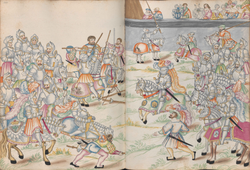|
|
You are not currently logged in. Are you accessing the unsecure (http) portal? Click here to switch to the secure portal. |
Wiktenauer:Main page/Featured
| “Die Blume des Kampfes” | |
|---|---|
| The Flower of Battle | |

| |
| Author(s) |
|
| Ascribed to |
|
| Illustrated by | Unknown |
| Date | before 1420s |
| Genre | |
| Language | Early New High German |
| State of Existence | Original hypothetical; multiple incomplete copies exist |
| Manuscript(s) |
|
| Concordance by | Michael Chidester |
Die Blume des Kampfes (“The Flower of Battle”) is a nickname given to a group of three German manuscripts that share a common technical syllabus and set of illustrations. It might possibly be based on the tradition of 14th century Italian master Fiore de'i Liberi, from whose treatise Fior di Battaglia it derives its nickname, given that his works include considerable technical overlap. It is equally likely, though, that they represent an earlier German tradition of which Fiore was himself an initiate. Fiore mentions in his prefaces that he owned books on the art and he also names two older masters in his tradition, Johane Suveno and Nicholai de Toblem; it is possible that either or both of those masters authored texts which inspired both this tradition as well as Fiore's own writings.
The oldest manuscript in the Blume des Kampfes group is the Cod. 5278, which dates to the late 1420s and contains only simple line drawings somewhat reminiscent of the art of Fiore de'i Liberi, though lacking many signature characteristics such as garters and crowns and generally less organized than the Friulian master's work. The second entry was completed in ca. 1500 by Ludwig VI von Eyb, and while contains a significant degree of overlap with the 5278, both manuscripts also have a wealth of unique content. While the artwork, though colored, is of similar quality, Eyb's treatise improves on its predecessor by including detailed German descriptions of the devices in most of its sections. Whether this text was authored by Eyb or present in the sources upon which he based his work cannot currently be determined.
The final manuscript, Cod. 10799, is dated 1623 and is again textless. Unlike its fellows, though, it is illustrated with watercolors of high quality; it is also the most extensive of the three by far, encompassing nearly every device from both works as well as a number of unique devices that suggest that it was either not derived directly from the other two known manuscripts or that it used additional sources currently lost to us. The two older manuscripts include war books derived from Konrad Kyeser's famous treatise on siege warfare Bellifortis, and the artist of the 10799 also included the few Bellifortis illustrations that seem to portray knights and soldiers, perhaps indicating that he did not understand what he was copying. Aside from the Blume des Kampfes material, the 10799 also has a good deal of extra content including portrayals of laying down and taking up the sword, Germanic sash wrestling, armored dagger and buckler, and the sword dance.
There is a fourth Germanic manuscript potentially connected to this tradition, the Cod.Guelf.78.2 Aug.2º. This manuscript, dating to between 1465 and 1480, includes a version of Johannes Liechtenauer's record, a complete set of illustrations from Gladiatoria, and a heavily-abridged version of Bellifortis. Tucked away amidst these works are illustrations of fencing with sword, spear, axe, and dagger that parallel the teachings of the Blume des Kampfes but only occasionally replicate the artwork exactly. While this may simply be a case of an overambitious artist reinterpreting the illustrations he was copying, the differences are too many to include the manuscript in the concordance below.
(Read more...)
